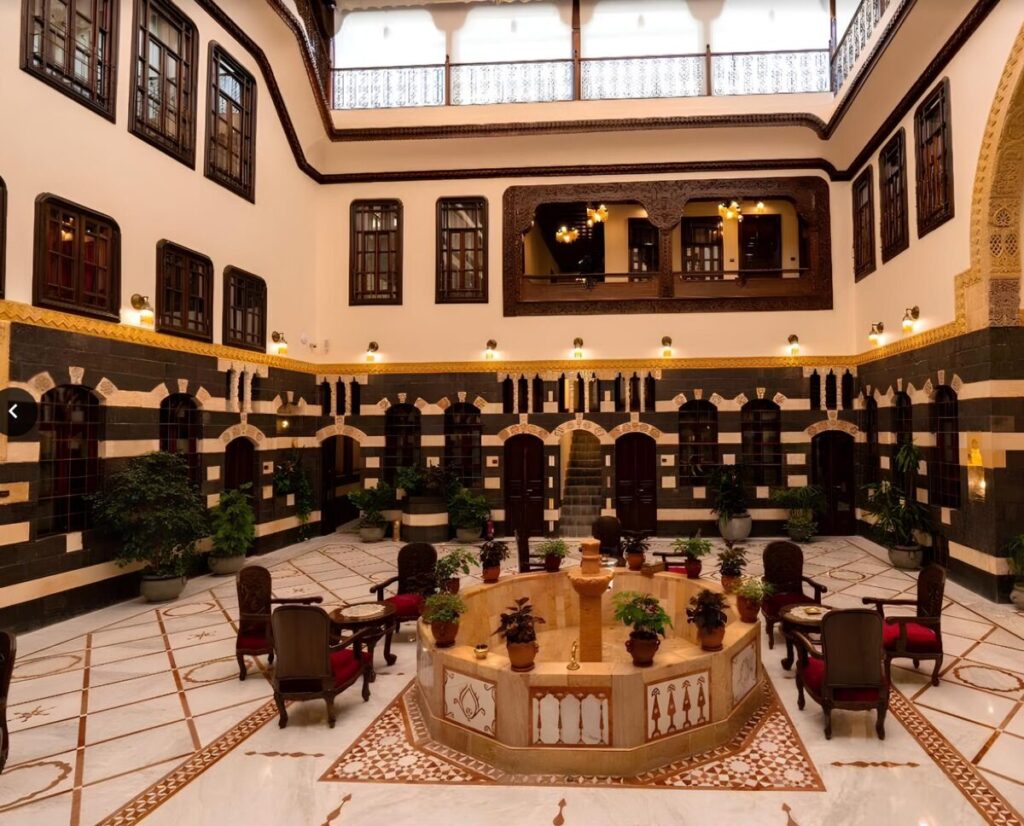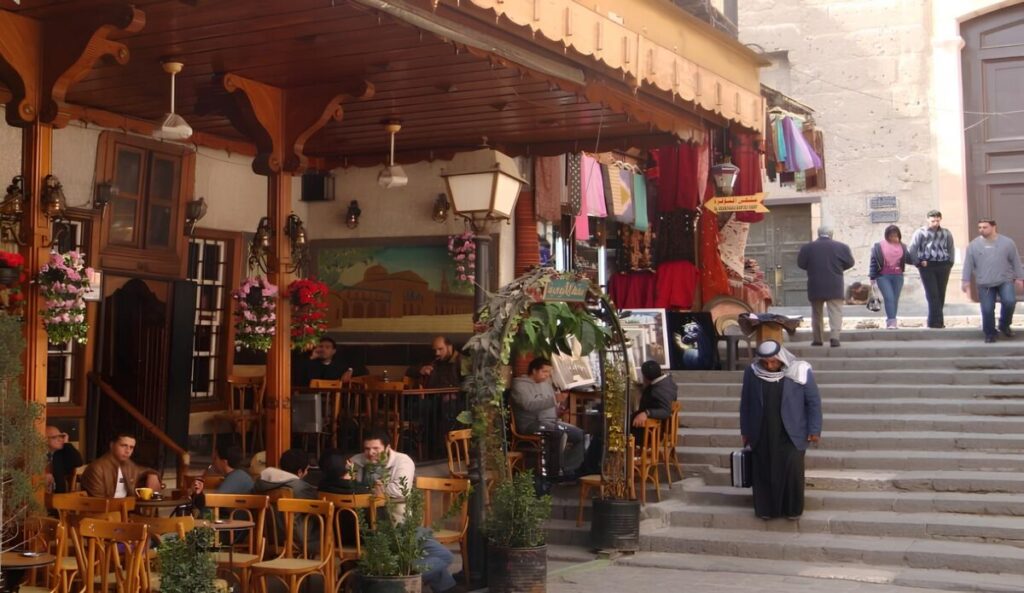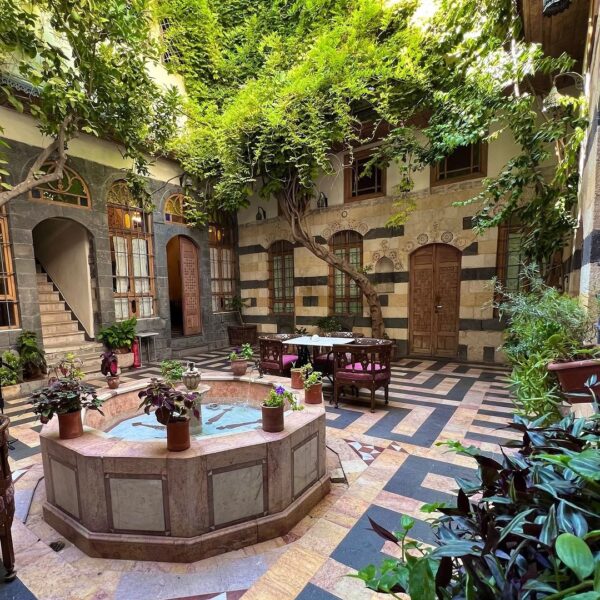Traditional Syrian houses, symbols of a unique architectural heritage, are in great danger. For centuries, these dwellings, with their lush inner courtyards and gardens of jasmine and roses, have represented an essential part of the country's cultural heritage. However, years of conflict as well as modern constructions threaten the existence of these buildings and, along with them, a part of Syria's historical identity. Innovative and creative local initiatives are therefore emerging to try to preserve and restore these architectural treasures, while revitalizing the local economy.
Traditional Syrian houses are characterized by a layout centered around an inner courtyard, the heart of the dwelling. This living space open to the sky is often adorned with plants such as the jasmine of Damascus (Jasminum sambac), the rose of Damascus (Rosa × damascena), or the bitter orange tree (Citrus aurantium). It also features fountains and mosaics, creating a combination of light and coolness appreciated in this family gathering place.
Climate Properties
Built with natural materials such as stone, raw brick, wood, and lime, these houses offer excellent thermal insulation, essential to withstand the hot climate.
The dome roofs, very characteristic, allow optimal rainwater management while enhancing insulation. Inside, elaborate decorations reflect a rich artisanal know-how: geometric, floral, and calligraphic motifs adorn the ceilings, doors, and windows. Finally, the houses are carefully oriented to maximize natural light and protect against prevailing winds. This architecture allowed people to live in densely populated areas while maintaining their privacy.
Buildings threatened by oblivion
Traditional Syrian houses are therefore a living reminder of Syria's rich cultural heritage. However, many of them are falling into ruin. The years of war have not only made maintenance difficult but have also diverted the attention of authorities and the population from preserving this heritage.
To counter this threat, several local projects have taken shape, transforming houses into boutique hotels, restaurants, or cafes. In Damascus, for example, in the Jewish, Christian, and Muslim quarters, once abandoned houses are being renovated and redesigned to welcome tourists and visitors eager to discover an authentic Syrian way of life. Such as Mamlouka transformed into a heritage hotel. Every visitor can admire a vast inner courtyard and a large open space, orange and lemon trees, jasmine, a pool, and a liwan furnished with brocade fabrics that narrate the details of a place dating back to the 17th century.
Transform to Preserve
The owner, Anton Maznar, emphasizes the importance of "preserving the ancient Damascene houses, as they contain treasures of heritage and a civilization that date back hundreds of years." And he adds: "We have transformed the house into a hotel that combines heritage and civilization, preserving its architectural features and making some service modifications." The house consists of 8 rooms, including 4 doubles and 4 suites, each named after historical figures and distinguished by its decoration, space, and furniture.

The Al-Wali House is another example of a heritage hotel in old Damascus. It is considered the largest in terms of area, consisting of three houses open to each other dating back to the 18th century. According to Edward Merza, its owner, "the entrances have been modified to enhance their brilliance, while the rooms, old wooden doors, windows, and oriental details have been preserved to keep the charm of the past and associate it with the modernity of the present."
Another well-preserved treasure is the Al-Nawfara coffee shop, located in the heart of the old city of Damascus. With over 500 years of history, it is considered the oldest coffee shop in the city. Its name comes from an impressive fountain that was once located nearby. This historically rich place offers an authentic atmosphere with its traditional architecture, wooden and wrought iron furniture, and its basalt-paved courtyard. It is particularly renowned for perpetuating the tradition of storytellers who entertain customers with their tales.
Financial and Administrative Obstacles
However, these initiatives are sometimes challenging. Restoring traditional houses requires significant investments, often beyond the reach of local developers, especially because it is rare to find someone capable of doing proper restoration work. NGOs and international aid may show interest, but this is still insufficient in the face of the high costs of renovation and administrative difficulties. The unstable political situation in Syria also complicates obtaining permits and investments, thus hindering progress.
Despite the obstacles, these initiatives remain hopeful. Because rehabilitating these traditional houses is preserving a part of the Syrian soul. "By integrating these homes into the economic fabric through tourism and restoration, the local population is made aware of the importance of heritage conservation. Visitors, whether Syrian or foreign, are invited to discover an authentic way of life and to participate, on their scale, in the preservation of this cultural wealth," says a local official wishing to remain anonymous.
The importance of local and international partnerships
To go further, the support of international organizations and specialized NGOs in the protection of heritage is crucial. A concrete example is the involvement of UNESCO, which works to convince local authorities of the importance of protecting these treasures. Crowdfunding campaigns are also emerging, allowing Syrian and international citizens to contribute to the restoration of these iconic houses.
A window to the future
Traditional Syrian houses are not just relics of the past; they are a bridge to the future. Their restoration and transformation into modern living spaces while preserving their unique character are essential to safeguarding the country's cultural identity.
Faced with financial, administrative, and political challenges, the creativity and resilience of project leaders show that it is possible to save this heritage by finding innovative and sustainable solutions. Together, local and international stakeholders can ensure that these houses continue to tell the story of Syria to future generations.

Cover Photo: The courtyard of Al Mamlouka where one can see the three plants traditionally planted (on the far left a bitter orange tree, in the middle the jasmine, and on the right corner a rose bush) @Al Mamlouka
